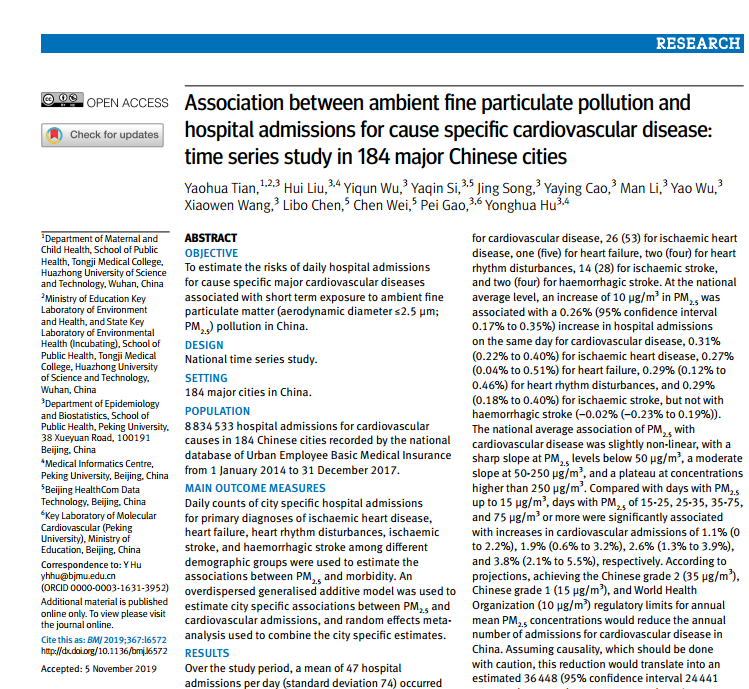Wuhan, China — On December 30, 2019, Associate Professor Tian Yaohua from School of Public Health, Tongji Medical College, Huazhong University of Science and Technology, in collaboration with Professor Hu Yonghua and Gao Pei, Peking University, published a paper, titled “Association between ambient fine particulate pollution and hospital admissions for cause specific cardiovascular disease: time series study in 184 major Chinese cities” in The BMJ (IF=27.6). This study provides scientific evidence for assessing the health effects of air pollution in Chinese population.
Cardiovascular disease is the leading cause of death and disability worldwide. A large body of epidemiological and clinical research has shown the adverse effects of short term exposure to ambient air pollution on cardiovascular health. However, most evidence of the association was assessed in developed countries. In addition, the associations between PM2.5 and morbidity of cause specific cardiovascular diseases have been limited, particularly in developing countries. The effects of PM2.5 at high concentrations on cardiovascular morbidity, especially on cause specific cardiovascular diseases, remain uncertain.
We conducted a national time-series study between 2014 and 2017 across 184 cities in China. City-specific associations between PM2.5 concentrations and hospitalization of cause specific cardiovascular diseases was firstly estimated by the over-dispersed generalized linear model and then combined by random-effects meta-analysis. Total 8.8 million admissions for cardiovascular causes were identified during the study period. At the national average level, an increase of 10 μg/m3 in PM2.5 was associated with a 0.26% (95% confidence interval 0.17% to 0.35%) increase in hospital admissions on the same day for cardiovascular disease, 0.31% (0.22% to 0.40%) for ischaemic heart disease, 0.27% (0.04% to 0.51%) for heart failure, 0.29% (0.12% to 0.46%) for heart rhythm disturbances, and 0.29% (0.18% to 0.40%) for ischaemic stroke, but not with haemorrhagic stroke (-0.02% (-0.23% to 0.19%)). Short term exposure to PM2.5 is associated with increased hospital admissions for major cardiovascular disease, even for exposure levels not exceeding the current regulatory limits. The national average association of PM2.5 with cardiovascular disease was slightly non-linear, with a sharp slope at PM2.5 levels below 50 μg/m3, a moderate slope at 50-250 μg/m3, and a plateau at concentrations higher than 250 μg/m3. According to projections, achieving the World Health Organization (10 μg/m3) regulatory limits for annual mean PM2.5 concentrations would reduce nearly 100 000 hospital admissions for cardiovascular disease and save the medical cost of over ¥1bn annually.
This study is the first nationwide investigation in China of the association between PM2.5 levels and hospital admissions for cardiovascular morbidity. These data could help inform policy makers regarding ambient air quality standards and management of public health disease.
Chinese News Link: http://gwxy.tjmu.edu.cn/info/1067/3148.htm


